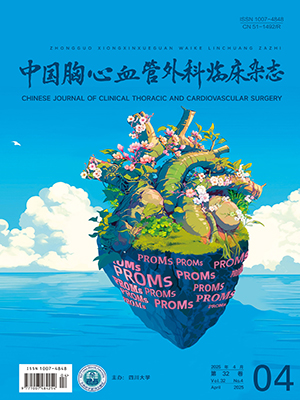| 1. |
Kleinman CS, Tabibian M, Starc TJ, et al. Spontaneous regression of left ventricular dilation in children with restrictive ventricular septal defects. J Pediatr, 2007, 150(6): 583-586.
|
| 2. |
Anderson RH, Wilcox BR. The surgical anatomy of ventricular septal defect. J Card Surg, 1992, 7(1): 17-35.
|
| 3. |
Sim EK, Grignani RT, Wong ML, et al. Outcome of surgical closure of doubly committed subarterial ventricular septal defect. Ann Thorac Surg, 1999, 67(3): 736-738.
|
| 4. |
Chiu SN, Wang JK, Lin MT, et al. Aortic valve prolapse associated with outlet-type ventricular septal defect. Ann Thorac Surg, 2005, 79(4): 1366-1371.
|
| 5. |
Cheung YF, Chiu CS, Yung TC, et al. Impact of preoperative aortic cusp prolapse on long-term outcome after surgical closure of subarterial ventricular septal defect. Ann Thorac Surg, 2002, 73(2): 622-627.
|
| 6. |
Mavroudis C, Baker CL, Idriss FS. Ventricular septal defect. In: Mavroudis C, Baker CL. Pediatric Cardiac Surgery. 3rd ed. Philadelphia: Mosby, 2003. 298-320.
|
| 7. |
Demirag MK, Keçeligil HT, Kolbakir F. Primary surgical repair of ventricular septal defect. Asian Cardiovasc Thorac Ann, 2003, 11(3): 213-216.
|
| 8. |
苏肇伉. 先天性心脏病微创手术的发展趋势. 中国胸心血管外科临床杂志, 2005, 12(4): 229-231.
|
| 9. |
Lun K, Li H, Leung MP, et al. Analysis of indications for surgical closure of subarterial ventricular septal defect without associated aortic cusp prolapse and aortic regurgitation. Am J Cardiol, 2001, 87(11): 1266-1270.
|
| 10. |
Tweddell JS, Pelech AN, Frommelt PC. Ventricular septal defect and aortic valve regurgitation: Pathophysiology and indications for surgery. Semin Thorac Cardiovasc Surg Pediatr Card Surg Annu, 2006, 9: 147-52.
|
| 11. |
Szkutnik M, Qureshi SA, Kusa J, et al. Use of the Amplatzer muscular ventricular septal defect occluder for closure of perimembranous ventricular septal defects. Heart, 2007, 93(3): 355-358.
|
| 12. |
Lock JE, Block PC, McKay RG, et al. Transcatheter closure of ventricular septal defects. Circulation, 1988, 78(2): 361-368.
|
| 13. |
Chen ZY, Cao H, Ma YJ, et al. Transfemoral and perventricular device occlusions and surgical repair for doubly committed subarterial ventricular septal defects. Ann Thorac Surg, 2015, 99(5): 1664-1670.
|
| 14. |
尹森林, 李晓, 朱达, 等. 经胸穿刺封堵术治疗干下型室间隔缺损的安全性及有效性研究. 中国胸心血管外科临床杂志, 2014, 21(5): 628-631.
|
| 15. |
杨云龙, 徐路平. 国产新型钛镍合金室间隔缺损封堵器的组织相容性研究. 中华实用儿科临床杂志, 2009, 24(11): 842-843.
|
| 16. |
张胜康, 尹晓清, 徐朝军, 等. 室间隔缺损封堵术后残余分流的随访观察. 世界最新医学信息文摘, 2016, 16(75): 14-15.
|
| 17. |
普金海, 安永, 栾果, 等. 239例小儿室间隔缺损修补术后残余分流的近中期随访. 重庆医科大学学报, 2020, 45(4): 477-481.
|
| 18. |
高波涛, 郑景浩, 陈会文, 等. 婴幼儿室间隔缺损修补术后残余分流的自发愈合. 中国胸心血管外科临床杂志, 2011, 18(6): 507-509.
|
| 19. |
Kenny D, Tometzki A, Martin R. Significant aortic regurgitation associated with transcatheter closure of perimembranous ventricular septal defects with a deficient aortic rim. Catheter Cardiovasc Interv, 2007, 70(3): 445-449.
|
| 20. |
Lin K, Zhu D, Tao K, et al. Hybrid perventricular device closure of doubly committed subarterial ventricular septal defects: Mid-term results. Catheter Cardiovasc Interv, 2013, 82(3): E225-E232.
|
| 21. |
Zhu D, Lin K, Tang ML, et al. Midterm results of hybrid perventricular closure of doubly committed subarterial ventricular septal defects in pediatric patients. J Card Surg, 2014, 29(4): 546-553.
|
| 22. |
Nishimura RA, Otto CM, Bonow RO, et al. 2014 AHA/ACC guideline for the management of patients with valvular heart disease: Executive summary: A report of the American College of Cardiology/American Heart Association Task Force on practice guidelines. Circulation, 2014, 129(23): 2440-2492.
|
| 23. |
Carminati M, Butera G, Chessa M, et al. Transcatheter closure of congenital ventricular septal defects: Results of the European Registry. Eur Heart J, 2007, 28(19): 2361-2368.
|
| 24. |
Sullivan ID. Transcatheter closure of perimembranous ventricular septal defect: Is the risk of heart block too high a price? Heart, 2007, 93(3): 284-286.
|
| 25. |
Latham RA, Anderson RH. Anatomical variations in atrioventricular conduction system with reference to ventricular septal defects. Br Heart J, 1972, 34(2): 185-190.
|




